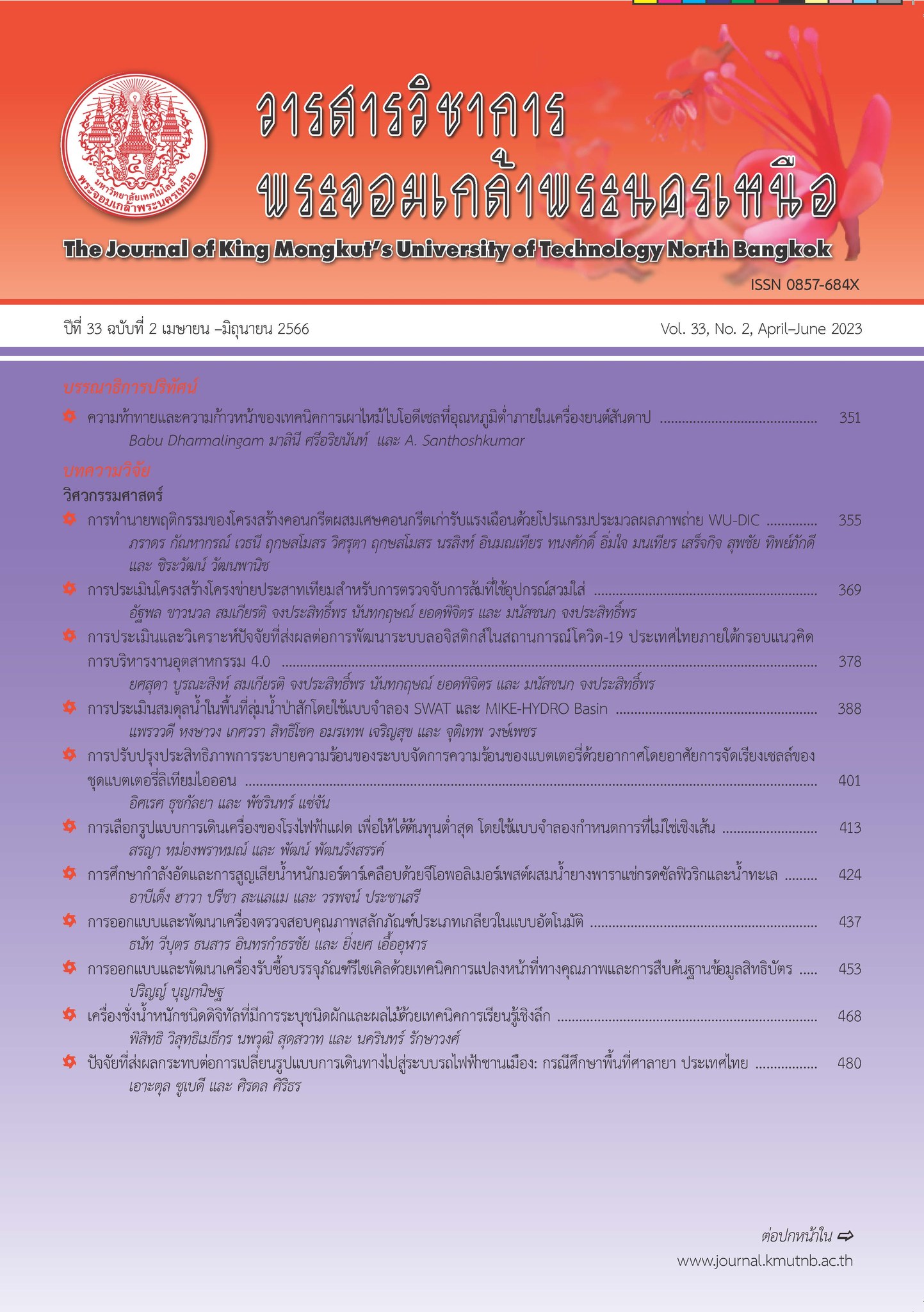การประเมินโครงสร้างโครงข่ายประสาทเทียมสำหรับการตรวจจับการล้มที่ใช้อุปกรณ์สวมใส่
Main Article Content
บทคัดย่อ
การล้มเป็นปัญหาที่สำคัญที่ทำให้เกิดการบาดเจ็บและการเสียชีวิต วัตถุประสงค์ของการศึกษานี้คือ เพื่อศึกษาโครงสร้างโครงข่ายประสาทเทียมที่เหมาะสมสำหรับการตรวจจับการล้มที่ใช้เซนเซอร์แอคเซเลอโรมิเตอร์และไจโรสโคป เทคนิคการทำขีดแบ่งและโครงข่ายประสาทเทียมถูกใช้เพื่อตรวจจับการล้ม การฝึกสอนและการทดสอบโครงข่ายประสาทเทียมใช้ข้อมูลที่ถูกเก็บจากผู้เข้าร่วมจำลองการล้มที่สวมใส่แอคเซเลอโรมิเตอร์และไจโรสโคปบนเอว ชุดข้อมูลฝึกอบรมและทดสอบประกอบด้วย การล้ม การยืน การนั่ง การวิ่ง และ การกระโดด ถูกเก็บและวิเคราะห์ แบบจำลองโครงข่ายประสาทเทียมด้วยโครงข่ายประสาทแบบแพร่กระจายย้อนกลับในรูปแบบป้อนไปข้างหน้าและใช้โครงข่ายประสาทเทียมเพอร์เซฟตรอนแบบหลายชั้นถูกทดสอบ ดัชนีการประเมินผลถูกใช้เพื่อระบุจำนวนเซลล์ประสาทในชั้นซ่อนระหว่าง 1 เซลล์ถึง 30 เซลล์ ผลการทดลองบ่งชี้ให้เห็นว่าในชั้นซ่อนควรมีเซลล์ประสาท 13 จำนวน และแสดงให้เห็นถึงความสามารถในการตรวจจับการล้มที่ให้ค่าความถูกต้อง ค่าความไว และ ค่าความจำเพาะในแต่ละค่าสูงถึง 1 ดังนั้น ระบบตรวจจับการล้มแบบใหม่ที่ใช้อุปกรณ์สวมใส่สามารถพัฒนาได้ในอนาคต
Article Details

อนุญาตภายใต้เงื่อนไข Creative Commons Attribution-NonCommercial-NoDerivatives 4.0 International License.
บทความที่ลงตีพิมพ์เป็นข้อคิดเห็นของผู้เขียนเท่านั้น
ผู้เขียนจะต้องเป็นผู้รับผิดชอบต่อผลทางกฎหมายใดๆ ที่อาจเกิดขึ้นจากบทความนั้น
เอกสารอ้างอิง
Division of Non Communicable Diseases. (2016). Fall prediction report in thai elderly. [Online]. Available: http://www.thaincd.com/
World Health Organization. (2015). WHO global report on falls prevention in older age. [Online]. Available: http://www.who.int/ageing/en
R. Igual, C. Medrano, and I. Plaza, “Challenges, issues and trends in fall detection systems,” BioMedical Engineering Online, vol. 12, no. 1. 2013.
J. Hamm, A. G. Money, A. Atwal, and I. Paraskevopoulos, “Fall prevention intervention technologies: A conceptual framework and survey of the state of the art,” Journal of Biomedical Informatics, vol. 59, Academic Press, pp. 319–345, 2016.
A. Danielsen, H. Olofsen, and B. A. Bremdal, “Increasing fall risk awareness using wearables: A fall risk awareness protocol,” Journal of Biomedical Informatics, vol. 63, pp. 184–194, 2016.
G. Koshmak, A. Loutfi, and M. Linden, “Challenges and issues in multisensor fusion approach for fall detection: Review paper,” Journal of Sensors, vol. 2016, 2016.
J. Qi, P. Yang, A. Waraich, Z. Deng, Y. Zhao, and Y. Yang, “Examining sensor-based physical activity recognition and monitoring for healthcare using Internet of things: A systematic review,” Journal of Biomedical Informatics, vol. 87, pp. 138–153, 2018.
A. Krogh, “What are artificial neural networks?,” Nature Biotechnology, vol. 26, no. 2. pp. 195– 197, Feb. 2008.
A. K. Bourke and G. M. Lyons, “A thresholdbased fall-detection algorithm using a bi-axial gyroscope sensor,” Medical Engineering & Physics, vol. 30, no. 1, pp. 84–90, Jan. 2008.
J. Dai, X. Bai, Z. Yang, Z. Shen, and D. Xuan, “PerFallD: A pervasive fall detection system using mobile phones,” Proceedings of the 8th IEEE International Conference on Pervasive Computing and Communications Workshops (PERCOM Workshops), 2010, pp. 292–297.
J. K. Lee, S. N. Robinovitch, and E. J. Park, “Inertial sensing-based pre-impact detection of falls involving near-fall scenarios,” IEEE Transactions on Neural Systems and Rehabilitation Engineering, vol. 23, no. 2, pp. 258–266, 2015.
J. Chen, K. Kwong, D. Chang, J. Luk, and R. Bajcsy, “Wearable sensors for reliable fall detection,” presented at the IEEE Engineering in Medicine and Biology 27th Annual Conference, Shanghai, China, 2005.
S. Abbate, M. Avvenuti, G. Cola, P. Corsini, J. Light, and A. Vecchio, “Recognition of false alarms in fall detection systems,” presented at the IEEE Consumer Communications and Networking Conference (CCNC), Las Vegas, NV, USA, 2011.
M. Lan, A. Nahapetian, A. Vahdatpour, L. Au, W. Kaiser, and M. Sarrafzadeh, “SmartFall: An automatic fall detection system based on subsequence matching for the smartcane,” Proceedings of the Fourth International Conference on Body Area Networks, 2011, p. 1.
Q. Li, J. A. Stankovic, M. A. Hanson, A. T. Barth, J. Lach, and G. Zhou, “Accurate, fast fall detection using gyroscopes and accelerometerderived posture information,” presented at the Sixth International Workshop on Wearable and Implantable Body Sensor Networks, Berkeley, CA, USA, 2009.
A. Yee-Loong Chong, M. J. Liu, J. Luo, and O. Keng-Boon, “Predicting RFID adoption in healthcare supply chain from the perspectives of users,” International Journal of Production Economics, vol. 159, pp. 66–75, 2015.
A. Y. L. Chong, “Predicting m-commerce adoption determinants: A neural network approach,” Expert Systems with Applications, vol. 40, no. 2, pp. 523–530, 2013.
A. Y. L. Chong, “A two-staged SEM-neural network approach for understanding and predicting the determinants of m-commerce adoption,” Expert Systems with Applications, vol. 40, no. 4, pp. 1240–1247, 2013.
M. Negnevitsky, Artificial intelligence: A guide to intelligent systems, 3rd ed., Canada, Pearson Education Canada 2011.
F. T. S. Chan and A. Y. L. Chong, “A SEMneural network approach for understanding determinants of interorganizational system standard adoption and performances,” Decision Support Systems, vol. 54, no. 1, pp. 621–630, Dec. 2012.
N. Győrbíró, Á. Fábián, and G. Hományi, “An activity recognition system for mobile phones,” Mobile Networks and Applications, vol. 14, no. 1, pp. 82–91, 2009.
Y. T. Chong and C.-H. Chen, “Management and forecast of dynamic customer needs: An artificial immune and neural system approach,” Advanced Engineering Informatics, vol. 24, no. 1, pp. 96–106, 2009.
A. Kamlungpetch and P. Inrawong, “Application of artificial neural networks with fast fourier transform for waveform analysis and classification,” The Journal of KMUTNB, vol. 27, no. 4, pp. 643–654, 2017.
A. Baratloo, M. Hosseini, A. Negida, G. El Ashal, and G. El Ashal, “Part 1: Simple definition and calculation of accuracy, sensitivity and specificity,” Emergency, vol. 3, no. 2. pp. 48–49, 2015.
A. K. Bourke, P.van de Ven, M.Gamble, R. O’Connor, K. Murphy, E. Bogan, E. McQuade, P. Finucane, G. O´ Laighin, and J. Nelson, “Evaluation of waist-mounted tri-axial accelerometer based fall-detection algorithms during scripted and continuous unscripted activities,” Journal of Biomechanics, vol. 43, no. 15, pp. 3051–3057, 2010.
D. Chen, W. Feng, Y. Zhang, X. Li, and T. Wang, “A wearable wireless fall detection system with accelerators,” in IEEE International Conference on Robotics and Biomimetics, 2011, pp. 2259–2263.
S. S. Khan and J. Hoey, “Review of fall detection techniques: A data availability perspective,” Medical Engineering & Physics, vol. 39, pp. 12–22, 2017.

